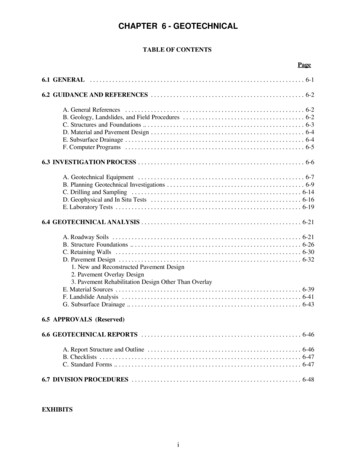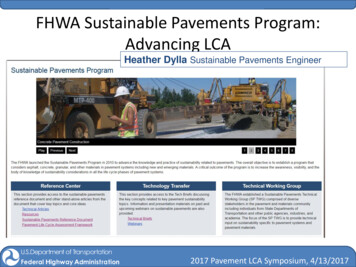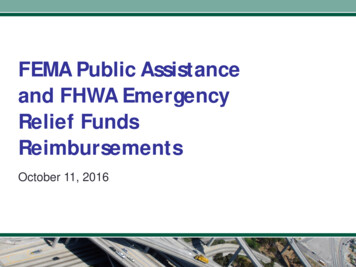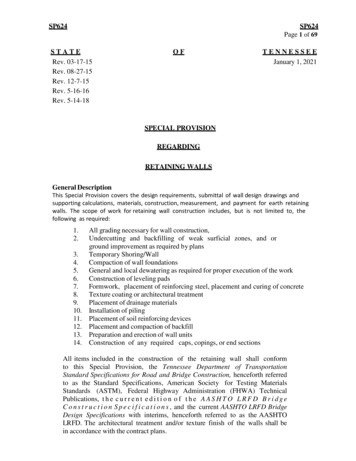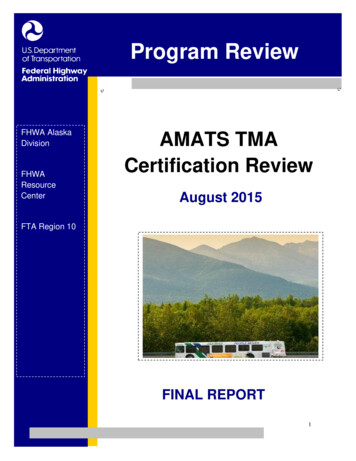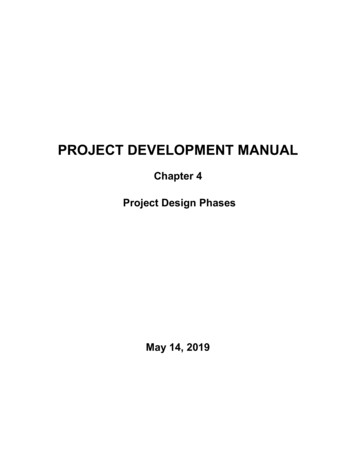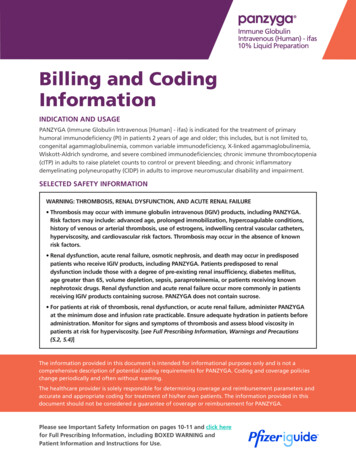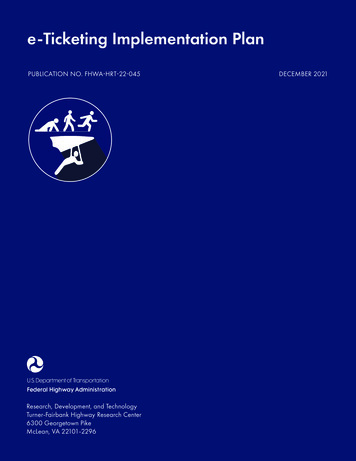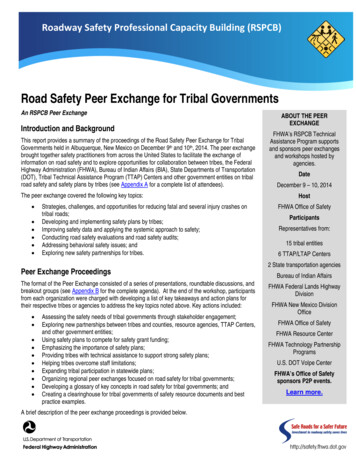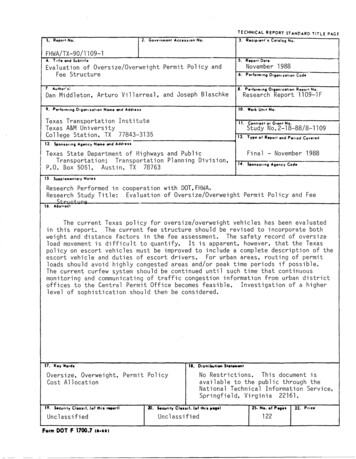
Transcription
TECHNICAL REPORT STANDARD TITLE PACF1. Report No.2. Gov rnment Acc uron No.3. Recipient's Cotolog No.FHWA/TX-90/1109-1S. Report Dote · Trtle ond SubtitleNovember 1988Evaluation of Oversize/Overweight Permit Policy andFee Structure6. P1trlormin; Or;onriotion Code78. Performing Or;oni zotion Report No.Author' slDan Middleton, Arturo Villarreal, and Joseph BlaschkeResearch Report 1109-lF10. Worlc Unit No.9. P1trform1n; Orgon1 zotoon Nom and AddressTexas Transportation InstituteTexas A&M UniversityCollege Station, TX 77843-313511. Contract or Gront No.Study No.2-18-88/8-1109 13. Type ol Report ond Period Cov red12. Sponsoring Agency Nome and AddressState Department of HighwaysI TexasTransportation; TransportationP.O. Box 5051, Austin, TX 78763and PublicPlanning Division,Final - November 1988I . Sponsoring Agency CodeIS. Supplementary NotesResearch Performed in cooperation with DOT,FHWA.Research Study Title: Evaluation of Oversize/Overweight Permit Policy and Fee :: .,., ,,. . .,.,,.16. AbstractThe current Texas policy for oversize/overweight vehicles has been evaluatedin this report. The current fee structure should be revised to incorporate bothweight and distance factors in the fee assessment. The safety record of oversizeload movement is difficult to quantify. It is apparent, however, that the Texaspolicy on escort vehicles must be improved to include a complete description of theescort vehicle and duties of escort drivers. For urban areas, routing of permitloads should avoid highly congested areas and/or peak time periods if possible.The current curfew system should be continued until such time that continuousmonitoring and communicating of traffic congestion information from urban districtoffices to the Central Permit Office becomes feasible. Investigation of a higherlevel of sophistication should then be considered.17. Key Wards18. Distribution Stot.,entOversize, Overweight, Permit PolicyCost Allocation19. Security Clouil. (of this rotiort)UnclassifiedForm DOT F 1700.7 c1.u 1No Restrictions. This document isavailable to the public through theNational Technical Information Service,Springfield, Virginia 22161.20. Soc:urity Cioni!. (of thi 1 pogo)Unclassified21. No. of Po; 12222. Price
EVALUATION OF OVERSIZE/OVERWEIGHT PERMIT POLICY AND FEE STRUCTUREbyDan R. MiddletonArturo VillarrealandJoseph D. BlaschkeResearch Report 1109-1 FResearch Study Number 2-18-88/8-1109Evaluation of Oversize/Overweight Permit Policy and Fee StructureSponsored byTexas State Department of Highways and Public Transportationin cooperation withU.S. Department of Transportation, Federal Highway AdministrationNovember 1988TEXAS TRANSPORTATION INSTITUTEThe Texas A&M University SystemCollege Station, Texas
ACKNOWLEDGEMENTThis project was sponsored by the Texas State Department of Highways and PublicTransportation (SDHPT). Dan Middleton and Arturo Villarreal served as Co-PrincipalInvestigators. Joseph Blaschke prepared the major portion of Chapter 3 in this reportconcerning safety and capacity issues. Charles Pinnell reviewed other state permitpolicies (Chapter 2) and tabulated pertinent parts for comparison with the Texas policy.Kenny Thong performed the computations for the proposed fee schedule described inChapter 5. Mr. Robert Guinn was the Contact Representative for the State Departmentof Highways and Public Transportation. Other individuals in the Department who deservespecial recognition are: Burt Lundell, John Panak, John Moorman, and Lenny Blumberg.ABSTRACTThe current Texas policy for oversize/overweight vehicles has been evaluated inthis report. The current fee structure should be revised to incorporate both weight anddistance factors in the fee assessment. The safety record of oversize load movement isdifficult to quantify. It is apparent, however, that the Texas policy on escort vehicles mustbe improved to include a complete description of the escort vehicle and duties of escortdrivers. For urban areas, routing of permit loads should avoid highly congested areasand/or peak time periods if possible. The current curfew system should be continueduntil such time that continuous monitoring and communicating of traffic congestioninformation from urban district offices to the Central Permit Office becomes feasible.Investigation of a higher level of sophistication should then be considered:SUMMARYThe principal objectives of this study include: review current policies in Texas andother states, evaluate impacts of overweight trucks on pavements and structures, evaluatesafety and capacity impacts of oversize trucks on the highway system, and developappropriate fee structure for oversize/overweight loads. The following states providedpermit policies for review and comparison with the Texas policy: Arkansas, California,Louisiana, New Mexico, Oklahoma, and Tennessee.Attempts to evaluate the safety record of permit loads were only marginallysuccessful. The only two types of loads with any accident information at all in Texas weremanufactured housing and concrete beams. According to information received from thePrecast Concrete Manufacturers Association (PCMA), concrete beam movement has beena relatively safe endeavor. In the case of manufactured housing, numbers of accidentsare recorded by the Texas Department of Public Safety (DPS), but determining mileagetraveled is practically impossible. Changes to the current escort policy for all oversizeloads have been recommended based on weaknesses identified in the current policy.Compliance with the state permitting requirements is also difficult to determine. Afield study on IH-10 in the Houston area indicated that approximately 40 to 60 percent of
the vehicles which should be permitted actually are permitted.Capacity considerations are important in the movement of oversize loads. Largeurban areas currently use a curfew system to limit the movement of these loads to offpeak periods. Recommendations of the study are to continue with the current curfewsystem until greater sophistication is available in monitoring traffic levels and in conveyinginformation to the Central Permit Office. At that time, the SDHPT computer network mightbe able to restrict the movement of oversize loads based upon congestion levels ratherthan a pre-established time period.A large sample of vehicle weights and travel distances from the Central PermitOffice records was used to determine a suitable fee structure. An appropriate finestructure must also accompany any change to the fee structure. The fee structure isbased on the premise that each vehicle class should pay for actual usage or damagedone to the highway infrastructure plus the cost of administering the permit system.Damage assessments are according to the AASHTO equation of pavement damage. Thisfee structure proposed for immediate use is in the form of a simple look-up table in orderto keep the permit issuance time to a minimum. Axle weights and distance traveled arethe primary input variables which each permit clerk will use to determine the fee. The levelof sophistication can and should be increased when the SDHPT incorporates automatedrouting techniques and develops the type of data base necessary.Increases in the administrative costs for super-heavy permit evaluations are alsoproposed based upon current SDHPT personnel and overhead costs. For all proposedchanges, compatibility with the Central Permit Operation is extremely important. Phasingof proposed changes is included.IMPLEMENTATION STATEMENTIt is apparent from the analysis involved in this study that an increase in permit feesis justified. This also means a commensurate increase in the fine structure. One permitcategory which should be given high priority is super-heavy permits. These permitsusually require structural engineering evaluations of each structure on a proposed route.Thus the administrative cost of a single permit can be quite high in comparison to thecurrent permit cost.SDHPT should begin implementing the recommendations contained in this reportas soon as possible. Because the fee structure is more equitable than the existingsystem, it should be easily justified, even though for many long distance trips, the permitfee will be greater than it now is.The SDHPT should continue in its current plan to implement an automated routingscheme as soon as possible. This will facilitate full implementation of the fee structureproposed in this report. Even though the network coding is very labor intensive, manyother benefits can be realized in areas other than permitting. Once implemented, thesystem can instantly reflect a change in status of a particular roadway segment.ii
DISCLAIMERThe views, interpretations, analysis, and conclusions expressed or implied in thisreport are those of the authors. They are not necessarily those of the Texas StateDepartment of Highways and Public Transportation.iii
TABLE OF CONTENTSCHAPTER 1. CURRENT TEXAS PRACTICE . . . . . . . . . . . . . . . . . . . .INTRODUCTION.IMPLEMENTING THE CENTRALIZED PERMIT PROCESS . . . . . . .PERMIT ACTIVITY IN FISCAL YEAR 1988 . . . . . . . . . . . . . . . . . . .MANUFACTURED HOUSING . . . . . . . . . . . . . . . . . . . . . . . . . . . .CONCRETE BEAMS . . . . . . . . . . . . . . . . . . . . . . . . . . . . . . . . . . .OILFIELD ACTIVITIES . . . . . . . . . . . . . . . . . . . . . . . . . . . . . . . . . .CHAPTER 2. CURRENT PERMIT PRACTICE IN OTHER STATES . . .INTRODUCTION.MAXIMUM STATUTORY WEIGHTS AND SIZES . . . . . . . . . . . . . . .MAXIMUM PERMIT WEIGHTS AND SIZES . . . . . . . . . . . . . . . . . .Permit Fees . . . . . . . . . . . . . . . . . . . . . . . . . . . . . . . . . . . .Maximum Weight for Single Axles . . . . . . . . . . . . . . . . . . . .Maximum Weight for Multiple Axles . . . . . . . . . . . . . . . . . . .Pounds per Inch of Tire Width . . . . . . . . . . . . . . . . . . . . . . .Overwidth Permits . . . . . . . . . . . . . . . . . . . . . . . . . . . . . . .Overheight Permit . . . . . . . . . . . . . . . . . . . . . . . . . . . . . . . .Overlength Permit . . . . . . . . . . . . . . . . . . . . . . . . . . . . . . . .Overlength Permit (Pipes and Poles) . . . . . . . . . . . . . . . . . .Overlength Permit (Poles, Piling, and Unrefined Timber) . . . .Manufactured Housing Permits . . . . . . . . . . . . . . . . . . . . . .Portable Building Permits . . . . . . . . . . . . . . . . . . . . . . . . . .Permits for Houses and Buildings . . . . . . . . . . . . . . . . . . . .Oil Well Clean-Out and/or Drilling Equipment Permits . . . . . .Permits for Unladen Lift Equipment (Mobile Cranes) . . . . . . .Permits for Water Well Drilling Machinery . . . . . . . . . . . . . . .Permits for Implements of Husbandry . . . . . . . . . . . . . . . . .Bonding . . . . . . . . . . . . . . . . . . . . . . . . . . . . . . . . . . . . . . .Governmental Exemptions . . . . . . . . . . . . . . . . . . . . . . . . .Escort Policy . . . . . . . . . . . . . . . . . . . . . . . . . . . . . . . . . . 3333333CHAPTER 3. CAPACITY AND SAFETY CONSIDERATIONS . . . . . . . .INTRODUCTION.ROADWAY CAPACITY CONSIDERATIONS . . . . . . . . . . . . . . . . . .OPERATIONAL SAFETY CONSIDERATIONS . . . . . . . . . . . . . . . . .Mobile Home Safety Record . . . . . . . . . . . . . . . . . . . . . . . .Concrete Beam Safety Record . . . . . . . . . . . . . . . . . . . . . .Literature Review . . . . . . . . . . . . . . . . . . . . . . . . . . . . . . . .3737CHAPTER 4. ENFORCEMENT ISSUES . . . . . . . . . . . . . . . . . . . . . . . .INTRODUCTION.FIELD STUDY.4949iv404242434550
TABLE OF CONTENTS (Continued)Introduction . . . . . . . . . . . . . . . . . . . . . . . . . . . . . . . . . . . .Methodology . . . . . . . . . . . . . . . . . . . . . . . . . . . . . . . . . . .Comparison with CPO Permits Issued . . . . . . . . . . . . . . . . .OTHER EVIDENCE OF COMPLIANCE.Concrete Beams . . . . . . . . . . . . . . . . . . . . . . . . . . . . . . . . .Manufactured Housing . . . . . . . . . . . . . . . . . . . . . . . . . . . .ENFORCEMENT CONCERNS EXPRESSED BY OILFIELD HAULERS50505556565859CHAPTER 5. PERMIT FEES . . . . . . . . . . . . . . . . . . . . . . . . . . . . . . . .IMPACT OF OVERWEIGHT TRAFFIC ON THE HIGHWAY SYSTEMPERMIT REVENUES AND ADMINISTRATIVE COSTS . . . . . . . . . . .ALTERNATIVE FEE SCHEDULE . . . . . . . . . . . . . . . . . . . . . . . . . .SUPER-HEAVY VEHICLE PERMITS.OVERWEIGHT FINES . . . . . . . . . . . . . . . . . . . . . . . . . . . . . . . . . .61CHAPTER 6. CONCLUSIONS AND RECOMMENDATIONS . . . . . . . . .RECOMMENDATIONS FOR IMPLEMENTATION . . . . . . . . . . . . . .RECOMMENDATIONS FOR FUTURE RESEARCH . . . . . . . . . . . . .717272REFERENCES.74APPENDIX75v6263646869
LIST OF FIGURESFigure1-11-21-31-41-51-61-72-14-14-2Central Permit Operation Overall System FlowchartCPO Permit Activity 1987/88 . . . . . . . . . . . . . . . . .CPO Vehicle Length Distribution . . . . . . . . . . . . . .CPO Vehicle Width Distribution . . . . . . . . . . . . . . .CPO Vehicle Height Distribution . . . . . . . . . . . . . .CPO Gross Vehicle Weight Distribution . . . . . . . . .Mobile Home Production in Texas . . . . . . . . . . . . .Comparison of Maximum Axle Loads . . . . . . . . . . .Field Study Site . . . . . . . . . . . . . . . . . . . . . . . . . .Field Study Site Layout . . . . . . . . . . . . . . . . . . . . .vi.68991O1O12285153
LIST OF 55-15-25-35-45-55-65-75-85-9Permits Issued by Field Offices . . . . . . . . . . . . . . . . .Mobile Home Sales Trends . . . . . . . . . . . . . . . . . . . .PCMA Survey Results . . . . . . . . . . . . . . . . . . . . . . . .Summary of Concrete Beam Permit Issuance by CPOLegal Weight and Size Limitations . . . . . . . . . . . . . . .State Permit Policies . . . . . . . . . . . . . . . . . . . . . . . . .State Escort Requirements . . . . . . . . . . . . . . . . . . . .Maximum Track Width . . . . . . . . . . . . . . . . . . . . . . .PCMA Survey Results . . . . . . . . . . . . . . . . . . . . . . . .Comparison of PCMA and SDHPT Proposals. . .DPS Summary of Weight Citations . . . . . . . . . . . . . . .Field Study Summary . . . . . . . . . . . . . . . . . . . . . . . .PCMA Survey Results . . . . . . . . . . . . . . . . . . . . . . . .Summary of Concrete Beam Permit Issuance by CPOMobile Home Sales Trends . . . . . . . . . . . . . . . . . . . .Vehicle Distribution . . . . . . . . . . . . . . . . . . . . . . . . . .Axle Load Distribution . . . . . . . . . . . . . . . . . . . . . . . .Loadings and Costs for the Sample Sections . . . . . . .Permit Revenues . . . . . . . . . . . . . . . . . . . . . . . . . . .Overweight Distribution . . . . . . . . . . . . . . . . . . . . . . .Trip Distance Distribution . . . . . . . . . . . . . . . . . . . . .Proposed Permit Fee Schedule . . . . . . . . . . . . . . . . .Super-Heavy Vehicle Permit Fee Comparison . . . . . .Proposed Fine Schedule . . . . . . . . . . . . . . . . . . . . . 70
CHAPTER 1. CURRENT TEXAS PRACTICEINTRODUCTIONAlthough there is a gross weight limit of 80,000 pounds for trucks on Texashighways, many loads cannot be reasonably reduced to be transported within the 80,000pound gross weight limit. Therefore, truckers need to operate at heavier weights, butwithin an appropriate permit system. This need conflicts with the design of most of theState's highway mileage, which does not adequately account for these excessive loads.The effect of these loads is an increased rate of deterioration of pavements and structuresat higher rates than originally expected. Some loads must also be transported which arelarger in size than the statutory limits; these too should be handled within an appropriatepermit procedure. Oversize loads which are wider than the nominal 8 feet or 8 feet 6inches, and/or longer than the regular tractor-semitrailer combination vehicle can easilycause operational and safety problems due to their size.Operational (capacity) problems are caused when other vehicles cannot maneuveras freely as they normally would. Oversize loads cause delays to vehicles traveling in thesame direction on the open highway where passing opportunities are more limited dueto the oversize vehicle. They also cause delays in urban areas, especially in a constrictedenvironment. Safety concerns must also be considered, especially when adequatemeasures are not taken to warn approaching motorists with warning signs, flashingbeacons, or properly marked escort vehicles.The Texas State Department of Highways and Public Transportation (SDHPT) iscurrently in the process of centralizing the permit issuing operation and making permitsavailable by telephone through toll-free lines. At the present time, permits are still beingissued in a few districts, but by the end of Calendar Year 1988, the remaining districts arescheduled to be implemented into the Central Permit Operation (CPO). This centralizationprocess will expedite the permitting procedure and will expand the hours of operation ascompared to the previous district permit issuance. Many other advantages will be realizedas discussed below.IMPLEMENTING THE CENTRALIZED PERMIT PROCESSCentralization of permitting started in 1986, providing truckers the capability ofacquiring permits by calling a toll-free number. SDHPT Division 18 tested the system inDistrict 14, fixed the initial problems, then took over the permit operation in that district onSeptember 27, 1987. Division 18 immediately relocated the whole district staff over to thePromontory Point office, located on the east side of Austin at the interchange of US 290and US 183. Previously, District 14 had permitting offices in Austin, Fredericksburg, andGiddings. The only time the district got involved after the changeover was if a truckerhad to use cash to pay for the permit instead of using the new credit card system. Thisinnovation provided for the purchase of permits or payment for temporary vehicleregistration via the credit card.At first, many truckers still wanted to use cash. Some truckers would travel fromFredericksburg to KerNille where they could use cash.Cash transactions have1
continued to be problematic for SDHPT (also referred to herein as the Department. Initialelectrical problems were solved, and in November of 1987 the CPO added eight WestTexas Districts. The general plan for incorporating districts into the CPO was to begin inthe west and proceed eastward until all districts were brought into the new system.Another unanticipated problem was the telephone system. Telemarketing was usedto pass incoming calls around to various available operators. Because the initialtelephone system for the CPO used parts of three telephone networks and was thus verycumbersome, special legislation was passed so that all downtown Austin offices could beon one system. SDHPT's 42 "800" numbers went through a single exchange, making thecall-in process much more efficient. Even then, when the CPO added the West Texasdistricts, callers began complaining that the CPO did not answer its phones. They weregetting a ring with no answer, which was a result of call blocking. Another complaint wasthat a caller would get in the queue, then get kicked out of line and get a dial tone.SDHPT finally realized the telephone company had provided a faulty system.In December of 1986, the legislative council had a private consultant study the phonesituation. Study results significantly impacted the legislature. The study indicated that theDepartment had bought a state-of-the-art piece of equipment designed for only 8,000lines, when there were 15,000 lines going into it. It was operating well above capacity.A consultant suggested switching to a different exchange, which was accomplishedin June, 1987. CPO has had a noticeable improvement in service. Since that time, twomore districts have been added: District 3 (Wichita Falls) and District 21 (Pharr). Elevendistricts were now included in the system. CPO immediately started looking for its owncall distributor system. To further upgrade the telephone system, SDHPT beganevaluating voice response units (VRU), which are basically very sophisticated answeringsystems. It will allow routing calls by geographic area, according to the origin of the load.One operational goal was to complete a permit on the phone in 1O minutes. It wastaking operators from 15 minutes to an hour with their current system. However, districtpersonnel had been doing this job 8 to 1O years and had dealt with local customers whoused the same route over and over. Familiarity with the customer across the counterallowed their time to be shorter.Some permits still have to be coordinated with districts. The new permit office askedfor authority to issue permits for loads up to 16 feet high and 16 feet wide withoutcoordination with the districts. Most districts have relinquished this much control. Somedistricts like Dallas want a call on anything 14 feet high or 14 feet wide, and they havegood reasons for doing that (low underpasses, etc.). Another district wanted to becontacted on everything 15 feet high and 14 feet wide during the week, but on theweekend they gave CPO full control to handle it. These are things which increaseprocessing time.Training cadre consisted of 34 experienced people. When telephone call wait timereached 30 minutes, 20 part-time college students were hired. CPO realized that it couldhire twice as many part-time people as full time. Students function as call takers; in other2
words, they take the place of the voice response unit. They take a call, screeninformation, and ask for a number for call-back. A problem developed, however. Manytruckers called from phone booths, and SDHPT could not return the call. So the truckerhad to call again.It takes from six weeks to three months to train a CPO officer with no permitexperience. The permit officer has to have a good knowledge of permit statutes, andsome of those are complex and need interpretation. Initially, truckers complained thatinterpretation was a big problem -- 24 highway departments with different interpretations.Hence, the SDHPT is now trying to bring about uniformity. Probably the most difficultchallenge for a new permit officer is learning the state's 73,000 mile roadway network.That's one reason why the Department is looking to the voice response unit -- to be ableto route calls geographically according to origin of load from six geographic areas. Quickresponse times will be developed when officers become familiar with a particular region.The voice response unit tells the operator to call a ticket number for the next trucker inthe queue from that particular geographic area. Obviously, this system is sophisticated.SDHPT even has the capability to issue permits for emergency movements at night.A duty clerk carries a telephone pager, district maps and the appropriate forms with himat night. The voice response unit will actually interface with the computer data base andallow the Department to authorize an emergency move. Each trucking company mustpurchase SDHPT maps so they can successfully route themselves and they must keepa bond and their credit card number on file at the Central Office. The Department will puta night script on the answering system which asks if the request is for an emergencymove. If it is, routine information is given, such as origin, destination, and otherappropriate permit information. The operator must then signal the computer to issue thenext permit number in its queue.The permit number is a combination of the year, month, day (6 digits), issue station(2 digits), and P (for permit) or R (for registration). When all information is exchanged, thetrucker has a valid permit. The Department of Public Safety (DPS) will not hesitate toissue a citation if a trucker is not permitted at night, even if it is an emergency move.The Department had originally estimated the telephone bill to be 700,000 per year.At the time when half the state was implemented, the bill is approximately 47,000 permonth. With full implementation, the annual bill could be over a million dollars. Of course,callers on hold contribute greatly to this cost. However, the voice response unit and otherplanned improvements should reduce the cost. In June of 1987, the Department was ableto add Districts 9 and 15, bringing the total to 13 districts in the system. There are 11more districts to add. On July 20, 1987, the CPO broke the 1,000 permit barrier (in asingle day); they issued 1,011 permits. Monday is typically the big day in the centralizedpermit operation. The districts collectively wrote 1,034 permits that same Monday, soSDHPT was about halfway through the complete centralization process.One big concern was getting more productivity out of the telephone system.Initially, the central office could only work one incoming call at a time, and if they had tocoordinate with a district, they had to hang up on the customer and call him back. A3
proposed addition will give them 100 preprogrammed speed-dial numbers, so they onlyneed to hit three numbers to call any district. It has a re-dial feature on the previousnumber, so it will give them a 20 to 40 percent increase in handling of the calls. Thesystem will allow them to work two calls at one time at each station. If the route is adifficult one, a three-way conversation is possible between the permit officer, the permitcoordinator in the district, and the trucker. The system has many other unique functions,but it does not provide routing assistance.Each district has a set of permit maps which contain a data base of the highwaysystem in that district, to include: weight bearing capacity of pavements, widths andheights of structures, and type of structures (impediments to movements). The CPOoperators rely on these maps quite heavily. They also use an interactive graphics designsystem. All of the districts now have at least one of these devices. They have digitizedall of these district permit maps and have stored them in graphics files. The districts arelinked together through an ethernet network so they can transmit whole graphic files. Itworks very well for transmitting files as long as the person on the receiving end knows ithas been sent.When a district plans to place reinforced concrete beams on a structure, the centralpermit office must be informed immediately so they can route loads accordingly. If aresurfacing job changes the vertical clearance, the CPO needs to know about it. TheDepartment has a very easy way to communicate such changes by simply entering theappropriate graphics file, making the change, and then sending an "E-mail" message sothat everybody gets the information. CPO operators rely heavily on accurate informationfrom the districts.Department personnel feel that the graphics system holds the potential forautomated routing. The parameters of the load -- weight first, then height, then width, andsometimes turning radius -- would be the system input. The output could be the actualroute rather than graphical format. CPO is currently considering some routing packagesproposed by various consultants.One problem encountered quite frequently is temporary construction restrictions.The Department may have to monitor 200 to 300 of these at any given time. The firstthing the district does is post the construction zone for "no permit loads." Usually, NewJersey barriers are placed at some point within the construction zone, reducing theroadway width. One construction restriction can affect an entire route. Availableclearance might easily vary by direction; a 16-foot clearance in one direction may be 15feet 6 inches in the other. Obviously, routing can be a complex problem.The central office has also contemplated upgrading their computers. TheDepartment's mainframe computer is an IBM 30840, but it is subject to malfunctioning atany time. Therefore, the Department decided not to use it for permit issuance. Instead,a local area network was selected using IBM XT PC's as issue machines linked togetherin a network. The system includes four AT file servers with tasks of network managementdivided, such as print server and upload server. The fourth file server is a spare. Theprimary file server manages the network and goes around every three minutes, gathers4
any permits which have been issued, and passes them over to the upload file server. Itsends the data to the mainframe. The Department has a permit enforcement file on themainframe which contains vehicle registrations. Within three minutes of issuance of apermit, DPS can check the files on this permit.Improvements anticipated in the future include upgrades in computers to 80386based machines with up to 280 megabytes of storage capability and upgrading from thePC network to the token ring network. A customer database is necessary because asmany as 70 to 80 percent of permit customers are repeat customers. The process ofpermit issuance for repeat customers could be expedited by asking a trucker when hecalls in if he uses this route three or more times a year. CPO could allow the companyto simply give them a number, thus saving keystrokes.The Central Permit Office uses a recorder which records all conversations betweentruckers and operators. Within three minutes,
Evaluation of Oversize/Overweight Permit Policy and Fee Structure 7 Author' sl Dan Middleton, Arturo Villarreal, and Joseph Blaschke . Arkansas, California, Louisiana, New Mexico, Oklahoma, and Tennessee. . category which should be given high priority is super-heavy permits. These permits
